Dakahlia is a governorate in the Nile Delta region of Egypt, known for its rich birdlife. The area is home to many species of birds, including migratory waterfowl, songbirds, raptors, and even some rare species of birds.
The most notable species are the Egyptian Vulture, Grey Heron, Black Kite, and White Stork. The diverse birdlife of Dakahlia provides an excellent opportunity for birdwatchers to observe and appreciate the variety of species in the area.
24 Birds to Watch in Dakahlia
Dakahlia is a governorate in northeastern Egypt, famous for its rich agricultural lands and historical monuments. But did you know it is also home to a diverse and colorful array of birds? Whether you are a birdwatcher, a nature lover, or just curious,
Here are 24 birds that you can spot in Dakahlia.
1. Mallard
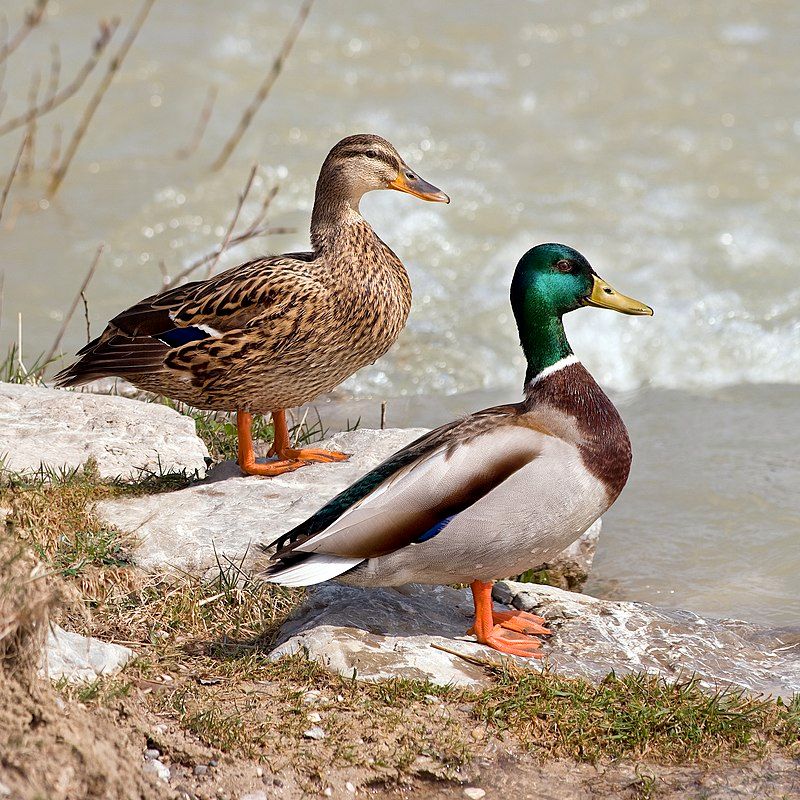
The mallard or wild duck is a species found in an extensive range of habitats worldwide. It is a dabbling duck, meaning it prefers shallow water to feed on aquatic plants, invertebrates, and small fish.
This duck species is native to temperate and subtropical regions in the Americas, Eurasia, and North Africa.
The mallard has been introduced to more regions in the past couple of centuries, including New Zealand, Australia, Peru, Brazil, Uruguay, Argentina, Chile, Colombia, the Falkland Islands, and South Africa.
This duck species can thrive in these habitats due to its adaptability and solid migratory capabilities. This has allowed the mallard to become one of the world’s most widely distributed species of waterfowl.
| Kingdom | Animalia |
| Phylum | Chordata |
| Class | Aves |
| Order | Anseriformes |
| Family | Anatidae |
| Genus | Anas |
| Species | A. platyrhynchos |
2. Eurasian Coot
The Eurasian coot, also known as the common coot or Australian coot, is a unique bird belonging to the Rallidae family of rails and crakes. It is widely distributed in Europe, Asia, Australia, New Zealand, and North Africa.
This species is quite distinct in appearance, with a slaty-black body, a glossy black head, and a white bill with a white frontal shield. Its wings are broad, and its tail is short and rounded. The Eurasian coot is a water bird that inhabits wetlands, lakes, and marshes.
It feeds on aquatic plants, small fish, insects, and crustaceans. It breeds during spring, laying up to ten eggs in a floating nest.
The chicks can swim and dive shortly after birth, but they depend on their parents for protection. The Eurasian coot is a gregarious bird that forms large flocks in winter. It is highly vocal and can be seen performing aerial displays during the breeding season.
It is also an aggressive species that will defend its territory from rivals. Overall, the Eurasian coot is a fascinating bird that plays a vital role in the wetlands it inhabits. Its unique appearance and exciting behavior make it a popular species among birdwatchers.
| Kingdom | Animalia |
| Phylum | Chordata |
| Class | Aves |
| Order | Gruiformes |
| Family | Rallidae |
| Genus | Fulica |
| Species | F. atra |
3. Shoveler
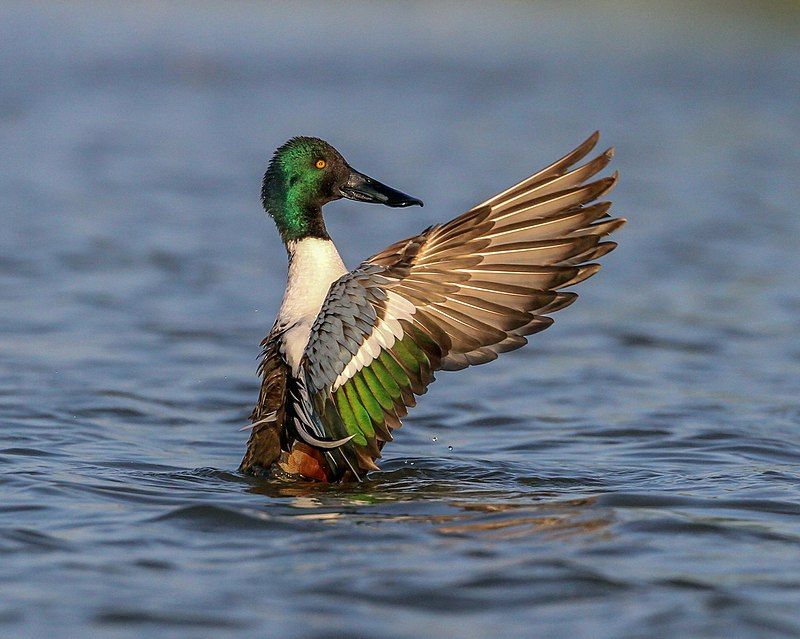
The northern shoveler, known as the shoveler in Britain, is a widespread duck species. It can be found in many countries across the Northern Hemisphere, Europe, and North America.
It can be found in northern areas of Europe and across the Palearctic during the breeding season. During the winter, it migrates to other regions, such as southern Europe, the Indian subcontinent, Southeast Asia, Central America, the Caribbean, and northern South America.
This species is a common sight in its native habitats and is easily identifiable by its large bill and colorful plumage.
The northern shoveler is an essential species in its native habitats, as it contributes to the local food chain and helps to maintain the balance of the local ecosystems.
| Kingdom | Animalia |
| Phylum | Chordata |
| Class | Aves |
| Order | Anseriformes |
| Family | Anatidae |
| Genus | Spatula |
| Species | S. clypeata |
4. Laughing Dove
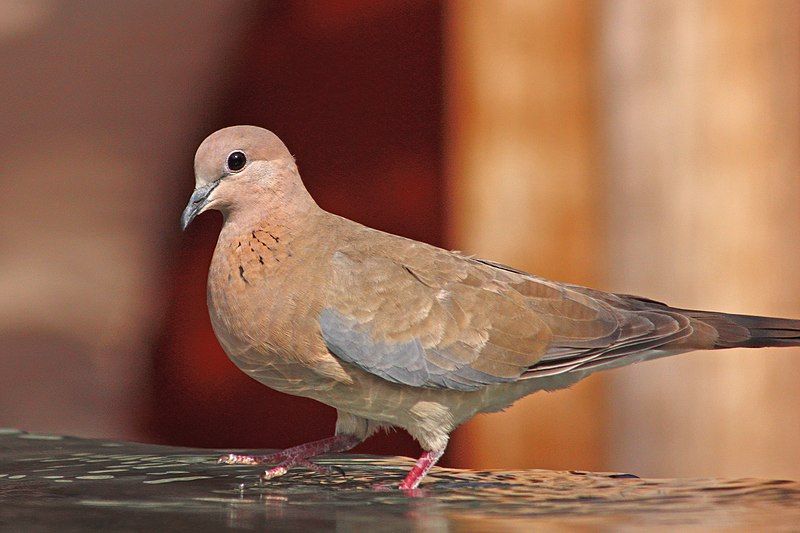
The Laughing Dove is a species of small pigeon that is found in a variety of regions across the world. It is a resident breeder in Africa, the Middle East, South Asia, and Western Australia.
In Western Australia, the Laughing Dove, released from Perth Zoo in 1898, has become a successful wild bird. This bird species is found in various habitats, including open woodland, savanna, farmland, and semi-desert.
It feeds mainly on seeds but may also eat insects, flowers, and buds. Its diet is supplemented with small lizards, snails, and spiders. The Laughing Dove is easily identified by its distinctive plumage, mainly greyish-brown with a pinkish hue.
Its wings are marked with dark bars, and its tail is tipped with white.
Its call is a loud, low-pitched dove-like cooing often heard in the early mornings and late afternoons. The Laughing Dove is a monogamous species, and males can be seen courting females with a bowing display.
The nest is a shallow platform of twigs, lined with grass and feathers, and is usually placed in a tree or bush. The female lays a clutch of two eggs, which are incubated for 13-14 days before hatching.
The young fledge after 16-18 days. The Laughing Dove is a widespread species whose population is not considered at risk. It is an essential species in many cultures and is often kept as a pet.
It is hunted for food in some areas, although this is generally not considered a significant threat to the species.
| Kingdom | Animalia |
| Phylum | Chordata |
| Class | Aves |
| Order | Columbiformes |
| Family | Columbidae |
| Genus | Spilopelia |
| Species | S. senegalensis |
5. Eurasian Teal
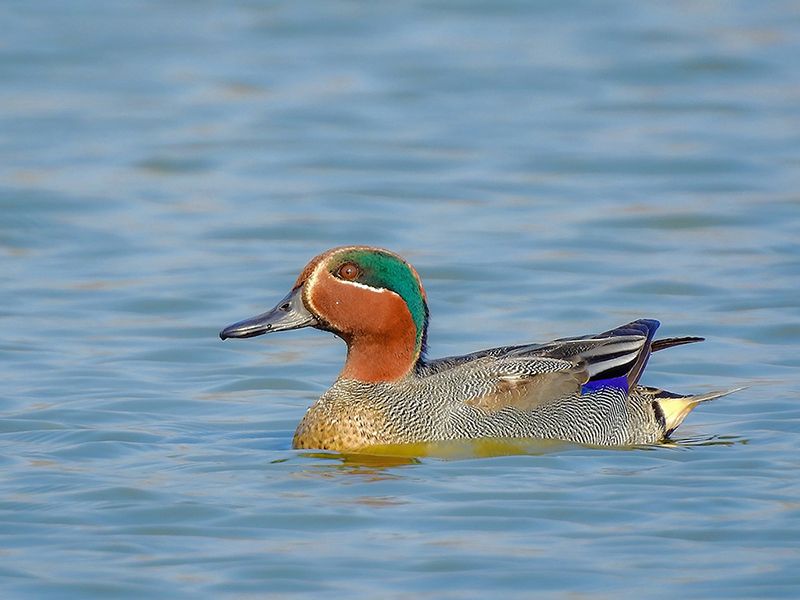
The Eurasian teal is a widespread duck found throughout temperate Eurosiberia. The bird is highly migratory and will travel south during the winter months.
It is often referred to simply as the ‘teal’ because it is the only species in much of its range. The bird is a dabbling duck, which means it feeds on the water’s surface rather than diving for food like other ducks.
Its diet consists of aquatic vegetation, small insects, and mollusks. The Eurasian teal is easily identified by its green head and neck, brown body, and white patches on its wings. Its call is a loud, high-pitched whistle, which can be heard during the breeding season.
| Kingdom | Animalia |
| Phylum | Chordata |
| Class | Aves |
| Order | Anseriformes |
| Family | Anatidae |
| Genus | Anas |
| Species | A. crecca |
6. Rock Dove
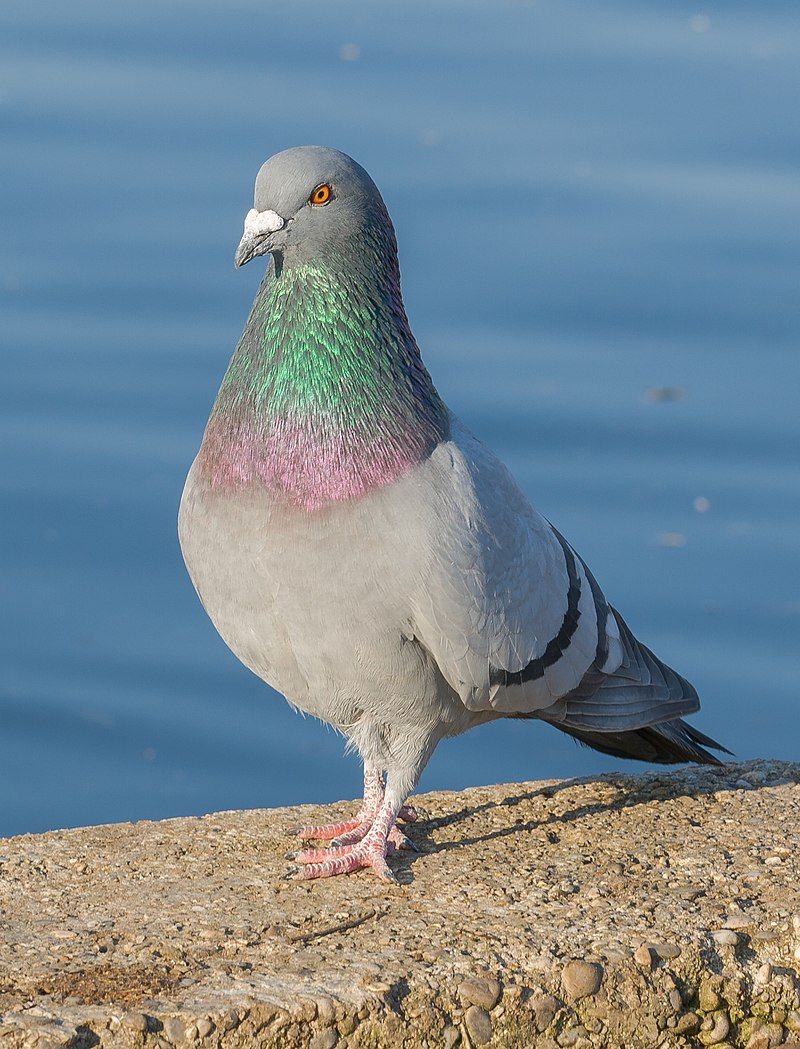
The rock dove, rock pigeon, or common pigeon is a species of bird that is part of the Columbidae family. It is most commonly referred to as the “pigeon” and is the ancestor of the domestic pigeon.
Due to domesticated pigeons escaping and breeding with wild birds, the population of feral pigeons worldwide has increased. Domestic pigeons have been bred for various reasons, such as racing, fancy shows, and meat.
In addition, they have been used as messenger pigeons to deliver messages over long distances. Domestication of pigeons began thousands of years ago, and they have been used in various ways since then.
Feral pigeons have also adapted to living in urban environments, thriving in cities and towns. They feed on food scraps, seeds, and other debris found on the ground.
Feral pigeons are also known to nest in buildings, bridges, and other structures, which can cause damage to these structures over time. Despite their ubiquity, rock doves, rock pigeons, and common pigeons are essential bird species.
They play a vital role in the environment, including being an important food source for various predators. In some areas, they are also seen as a symbol of peace and are even considered sacred in some cultures.
Overall, the rock dove, rock pigeon, and common pigeon are essential bird species with a long and varied history. They are the ancestors of the domestic pigeon and have contributed to the increased population of feral pigeons worldwide.
They are an essential part of the environment, and their presence is appreciated by many.
| Kingdom | Animalia |
| Phylum | Chordata |
| Class | Aves |
| Order | Columbiformes |
| Family | Columbidae |
| Genus | Columba |
| Species | C. livia |
7. Northern Pintail
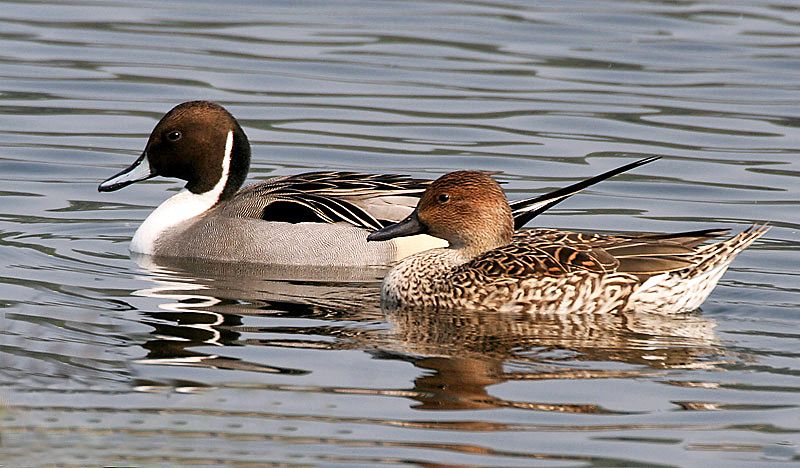
The pintail, also known as the northern pintail, is a species of duck widely distributed across the Northern Hemisphere. It breeds in northern parts of Europe and throughout the Palearctic and North American regions.
During winter, the pintail migrates southward from its breeding grounds, occasionally even reaching the equator. These ducks are typically found in shallow wetlands, feeding on aquatic plants and invertebrates.
They have long, pointed tails that distinguish them from other duck species. The males are generally more significant than the females, with brown-gray feathers on their bodies.
In the breeding season, the males also have a black and white stripe on their necks. The pintail population is generally considered to be stable.
However, the International Union for Conservation of Nature lists the species as Near Threatened due to habitat loss and hunting. In addition, climate change and winter storms have been decreasing the bird’s breeding success.
Conservation efforts are being made to help protect this species and its habitats.
| Kingdom | Animalia |
| Phylum | Chordata |
| Class | Aves |
| Order | Anseriformes |
| Family | Anatidae |
| Genus | Anas |
| Species | A. acuta |
8. Ferruginous Duck
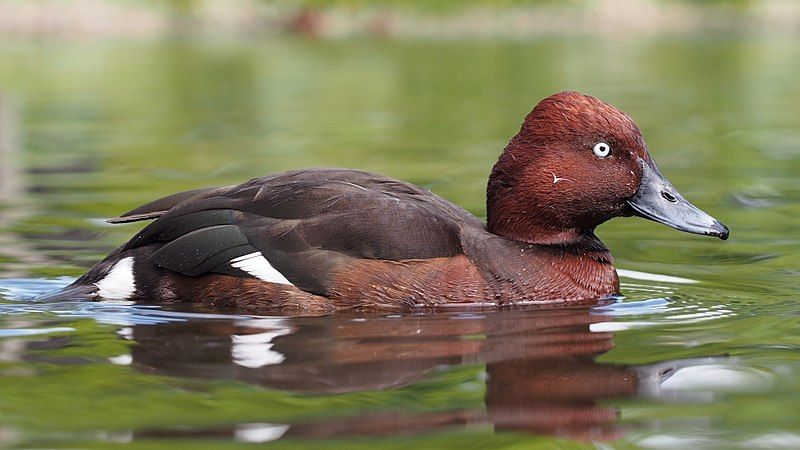
The ferruginous duck, also known as ferruginous pochard, common white-eye, or white-eyed pochard, is a medium-sized diving duck native to Eurosiberia.
It is a species of duck widely distributed across the continent, with populations in Russia, Scandinavia, and parts of the United Kingdom. The scientific name of this species, Aythya nyroca, is derived from Greek.
The first part of the name, Aythya, comes from the Greek word Lithuania, an unidentified seabird mentioned by authors including Hesychius and Aristotle. The second part of the name, Lyrica, is the Russian word for duck.
This duck species is easily recognized by its distinctive rusty-brown plumage, which gives it its name – ferruginous. It has a white eye ring and white upper wings. The male ferruginous duck is larger than the female, with a length of around 52 cm and a wingspan of around 95 cm.
The female is slightly smaller, with a length of around 46 cm and a wingspan of around 85 cm. This duck species is an excellent diver, able to stay underwater for extended periods. It feeds mainly on aquatic plants, invertebrates, and small fish.
The ferruginous duck is also a migratory species, with some populations traveling long distances to reach their wintering grounds. Overall, the ferruginous duck is a unique species of duck that is found across Eurosiberia.
Its scientific name is derived from Greek and Russian words, and its distinctive rusty-brown plumage easily recognizes it. This duck species is an excellent diver, feeding mainly on aquatic plants, invertebrates, and small fish.
| Kingdom | Animalia |
| Phylum | Chordata |
| Class | Aves |
| Order | Anseriformes |
| Family | Anatidae |
| Genus | Aythya |
| Species | A. nyroca |
9. Eurasian Wigeon
The Eurasian wigeon, also known as the European wigeon, widgeon, or just wigeon, is a type of duck belonging to the genus Mareca. It is one of three species of wigeon, the other two being American and Chiloë.
This particular wigeon species is one of the most widespread ducks in the Palearctic region.
This region includes much northern and central Europe, Asia, and North Africa. The Eurasian wigeon is a medium-sized bird, measuring about eighteen inches long and weighing about one and a half pounds.
Its head is light brown, with a black neck and white belly. Its wings are grayish-brown, with a white patch near the tips. It has a characteristic white line along the sides of its body.
The male Eurasian wigeon has a blue bill, whereas the female has a yellow bill. The Eurasian wigeon is a dabbling duck, meaning it feeds by submerging its bill in shallow water and scooping up food such as insects, crustaceans, and aquatic plants.
It is also known to eat grains and other vegetation on land. The Eurasian wigeon breeds in temperate and sub-arctic regions, typically nesting in marshes and wetlands. It is a migratory bird found in large numbers in Northern Europe during winter.
| Kingdom | Animalia |
| Phylum | Chordata |
| Class | Aves |
| Order | Anseriformes |
| Family | Anatidae |
| Genus | Mareca |
| Species | M. penelope |
10. Little Grebe
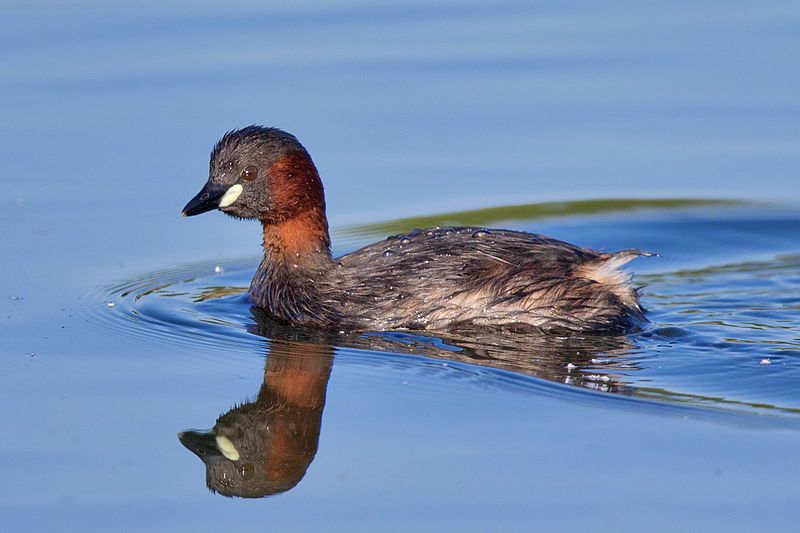
The little grebe, also known as the dabchick, is a bird found in water habitats. It belongs to the Grebe family of birds. Its scientific name, tachybaptus ruficollis, is derived from two words. The first word, tachys, is from Ancient Greek and means “fast”.
The second word, bapto, is also from Ancient Greek and means “to sink under.” The specific name, ruficollis, is derived from two different words.
The first word, Rufus, is Latin for “red,” and the second word, Collis, is a combination of Latin words, collum meaning “neck” and -collis meaning “-necked.” This scientific name reflects that the little grebe has a reddish neck.
| Kingdom | Animalia |
| Phylum | Chordata |
| Class | Aves |
| Order | Podicipediformes |
| Family | Podicipedidae |
| Genus | Tachybaptus |
| Species | T. ruficollis |
11. Common Wood Pigeon
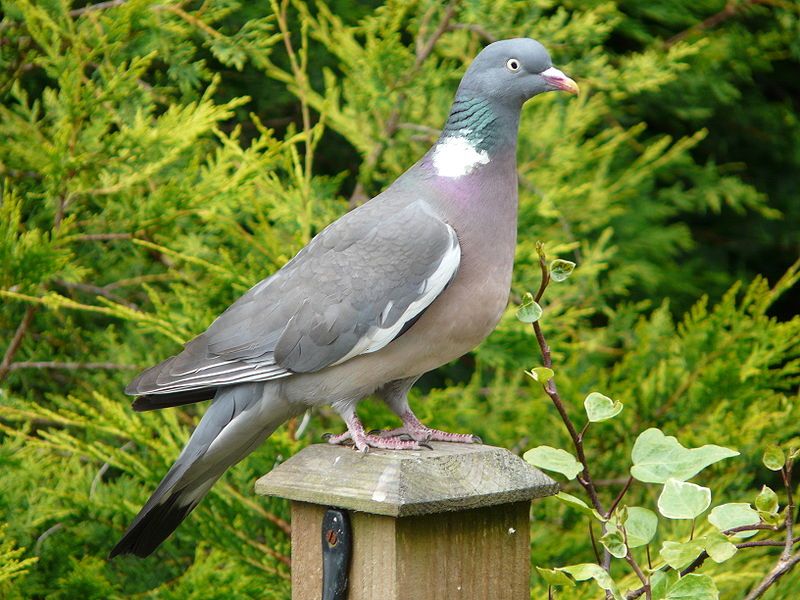
The standard wood pigeon is a species of dove and pigeon found in the western Palearctic region. It is a large species and is part of the genus Columba. This genus includes other closely related species, such as the rock dove.
This pigeon species can be found in various habitats, such as parks, gardens, and woodlands. It is common in some cities, where it often feeds on seeds from plants or scraps of food from bird tables. It is a social species and often roosts and feeds in flocks.
They also have an impressive flight – they can reach up to 70mph and cover hundreds of miles in just a few hours. The standard wood pigeon is a species that has adapted to humans, making it a famous bird to observe.
| Kingdom | Animalia |
| Phylum | Chordata |
| Class | Aves |
| Order | Columbiformes |
| Family | Columbidae |
| Genus | Columba |
| Species | C. palumbus |
12. Garganey
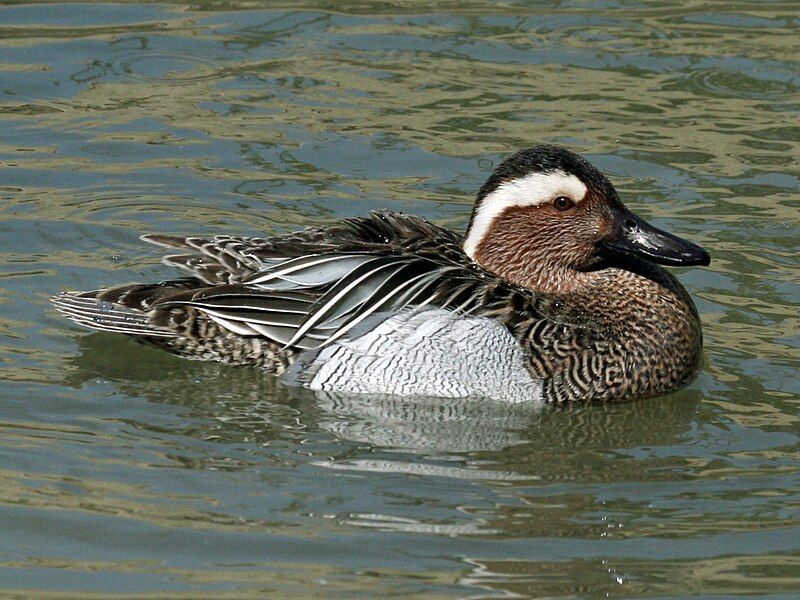
The Garganey is a small dabbling duck widely distributed across Europe and the Palearctic region. It breeds in these areas during the spring and summer months but migrates further south during the Northern Hemisphere’s winter months.
During these migrations, the entire population of Garganey ducks moves to warmer climates found in Africa, India, Bangladesh, and Australasia. Once there, they form large flocks, seen in wetlands and other bodies of water.
The Garganey’s migratory behavior is an adaptation that allows the species to survive during the colder winter months of the Northern Hemisphere.
Furthermore, this migratory behavior helps the species to find abundant food sources in the warmer climates of the south.
| Kingdom | Animalia |
| Phylum | Chordata |
| Class | Aves |
| Order | Anseriformes |
| Family | Anatidae |
| Genus | Spatula |
| Species | S. querquedula |
13. Gadwall
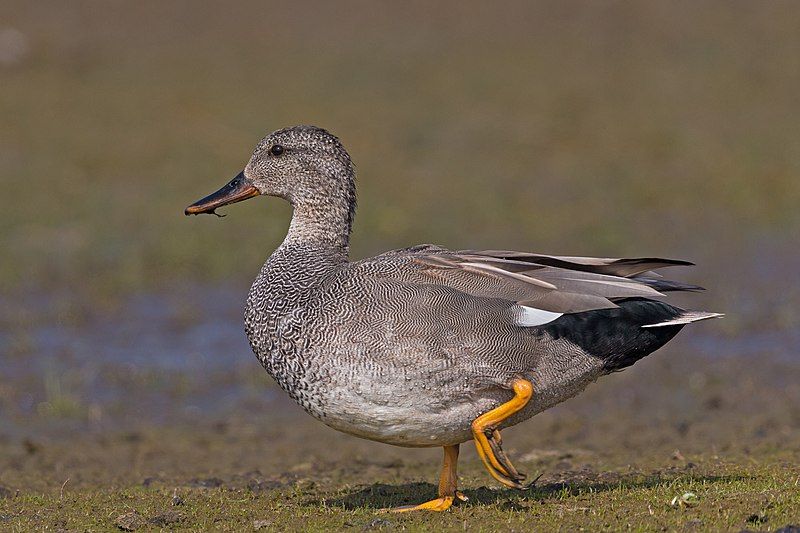
The gadwall is a species of duck in the family Anatidae. It is found in wetland habitats worldwide and is one of the most common ducks in North America. It is a large duck with a wingspan of up to 45 inches, and adults can weigh up to 3 pounds.
It has a gray and white body, head, and a black bill and tail.
Its white and gray wings have a distinctive white patch near the tips. Gadwalls usually feed by tipping or dabbling in shallow water, eating aquatic vegetation, insects, and the occasional small fish or crustaceans.
They are often seen in large flocks and will even form mixed-species flocks with other ducks. They are relatively quiet, and their call is a soft, low quack. Gadwalls usually nest in the spring, laying 6-12 eggs in a well-hidden nest on the ground.
The female will incubate the eggs for about 25 days. Both parents will care for the ducklings, leaving the nest within a day of hatching. The gadwall is an essential species for wetland conservation, as they are one of the primary grazers of aquatic vegetation.
They are also hunted in some areas, and wildlife management agencies monitor their population.
| Kingdom | Animalia |
| Phylum | Chordata |
| Class | Aves |
| Order | Anseriformes |
| Family | Anatidae |
| Genus | Mareca |
| Species | M. strepera |
14. Namaqua Dove
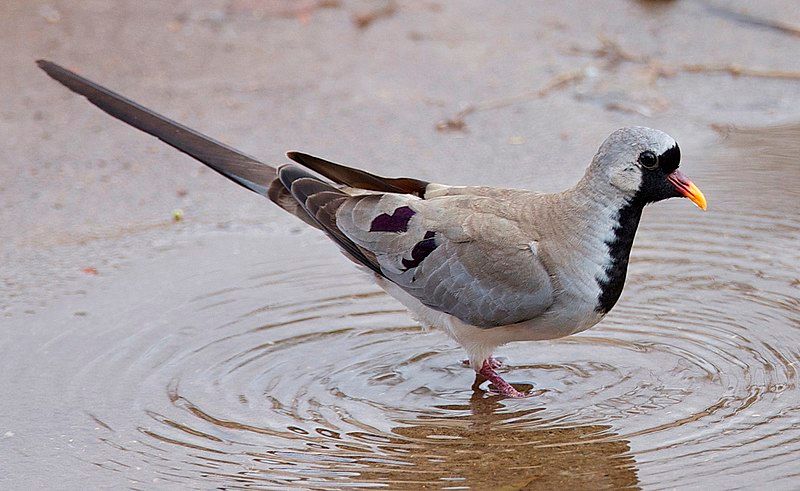
The Namaqua Dove is a small yet distinct species of pigeon. It is the only bird in the genus Oena, making it a unique species. This species is found in many different areas of Sub-Saharan Africa, as well as in parts of Arabia and Madagascar.
This species has a distinct reddish-brown coloring, with white spots and black streaks near its wings. The underside of this species is a pale yellow color. Its habitat is usually found in open woodlands, savannahs, and semi-deserts.
It prefers to feed on the ground, eating seeds, grains, and other small plant matter. The Namaqua Dove is a common species with a relatively stable population.
It is not considered to be threatened by any significant threats and is classified as a species of most minor concern by the International Union for Conservation of Nature.
| Kingdom | Animalia |
| Phylum | Chordata |
| Class | Aves |
| Order | Columbiformes |
| Family | Columbidae |
| Genus | Oena |
| Species | O. capensis |
15. Common Sandpiper
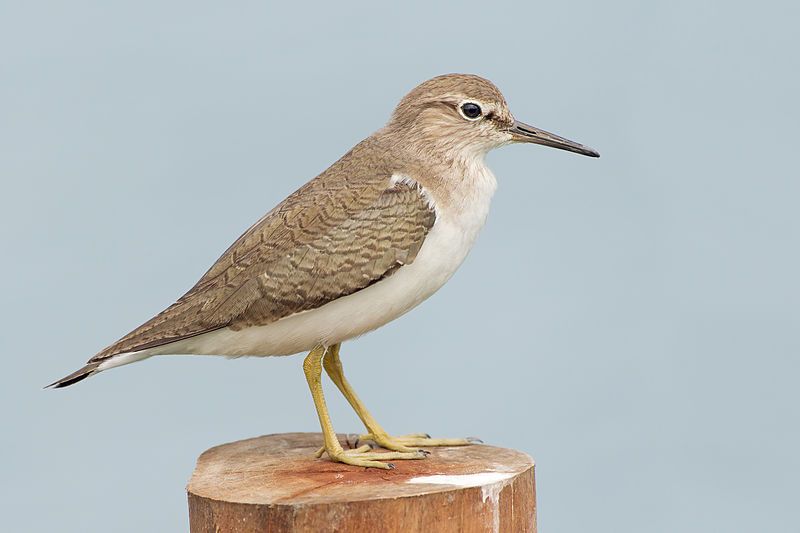
The common sandpiper is a small bird that belongs to the Palearctic wader family. It is one of two species that make up the genus Actitis, the other being the spotted sandpiper.
These two species are parapatric, meaning they occupy different geographical areas but can overlap, often leading to hybridization. This is because birds of either species can settle down with the breeders of the other and create hybrid offspring.
This hybridization can occur even if the two species were not found initially together, as birds may stray from their usual habitats.
Hybridization between the two species occurs more frequently than other species due to them occupying similar habitats and having similar calls.
| Kingdom | Animalia |
| Phylum | Chordata |
| Class | Aves |
| Order | Charadriiformes |
| Family | Scolopacidae |
| Genus | Actitis |
| Species | A. hypoleucos |
16. Sand Partridge
The sand partridge is a gamebird species belonging to the pheasant family, Phasianidae, of the order Galliformes. Galliformes is a group of gallinaceous birds, which includes a variety of species such as pheasants, partridges, chickens, turkeys, and quail.
The sand partridge has a native range that stretches from Egypt and Israel to south Arabia. It is a migratory species found in other parts of the Middle East, such as North Africa, Iran, and Iraq.
The sand partridge is a small bird, about the size of a domestic chicken, with a buff-brown back and white underparts. It has a long tail and a black head with white stripes running down the sides. Its diet consists of seeds, leaves, buds, and insects.
It usually lives in open scrubland and grassland but can also be found in agricultural areas. The sand partridge is hunted for sport and is considered a delicacy in some parts of the Middle East.
| Kingdom | Animalia |
| Phylum | Chordata |
| Class | Aves |
| Order | Galliformes |
| Family | Phasianidae |
| Genus | Ammoperdix |
| Species | A. heyi |
17. Black-Winged Stilt
The black-winged stilt is a species of wader, a bird that lives in wetland areas. It is part of the avocet and stilt family and is distinguished by its long legs. It has a wide range and is found in many different regions worldwide.
Its scientific name is H. himantopus, sometimes referred to as a single, global species. The black-winged stilt is an elegant and graceful bird with black wings, white feathers, and long, thin legs.
It is often seen wading in shallow waters, feeding insects, small fish, and crustaceans. It is a famous bird for birdwatchers, as it can be easily spotted when wading in the water or standing on the shore.
| Kingdom | Animalia |
| Phylum | Chordata |
| Class | Aves |
| Order | Charadriiformes |
| Family | Recurvirostridae |
| Genus | Himantopus |
| Species | H. himantopus |
18. Northern Lapwing
The northern lapwing is a species of bird that is part of the lapwing subfamily. It is widely distributed throughout temperate Eurosiberia and is known by various names, including peewit or pewit, tuit or twit, green plover, and eye wipe.
The northern lapwing is a medium-sized bird with a black crown, white forehead, and grayish-brown back. It has a white belly and long, pointed wings. Its tail is white with a black band at the tip. Its legs are yellow, and its beak is black.
The northern lapwing is a noisy bird with various vocalizations, including a distinctive peewit call that gives it one of its common names. It feeds on insects and worms and breeds in open grasslands and meadows.
During the breeding season, the northern lapwing will perform a display flight involving flying high in the air and diving rapidly toward the ground. This species is vital to local ecosystems as it helps to keep insect populations in check.
| Kingdom | Animalia |
| Phylum | Chordata |
| Class | Aves |
| Order | Charadriiformes |
| Family | Charadriidae |
| Genus | Vanellus |
| Species | V. vanellus |
19. Baillon’s Crake
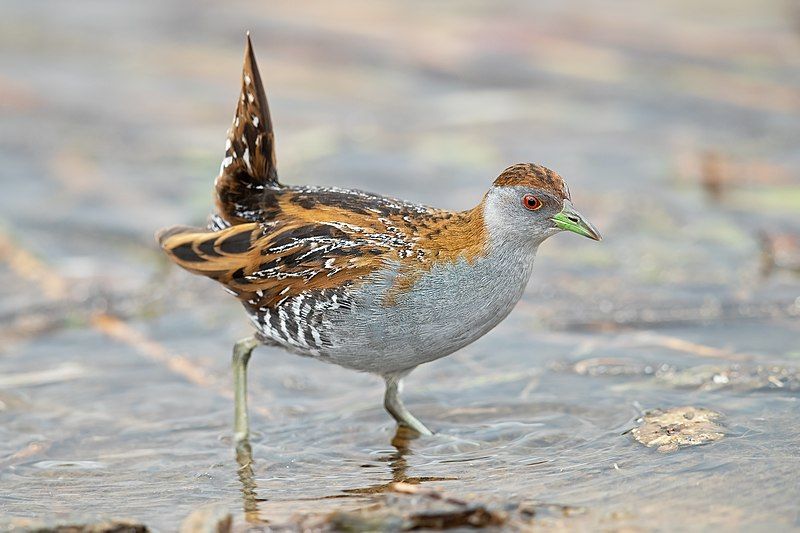
Baillon’s crake is a species of waterbird belonging to the family Rallidae, also known as the marsh crake. It is a small bird, typically measuring between 21 and 23 cm long and weighing around 50 grams.
The species is found in wetland habitats across much of northern and eastern Europe and parts of North America. It has a dark gray or black body, with a white face and breast. Its back is reddish-brown, and its tail is black.
The species feeds mainly on small aquatic invertebrates, such as insects, snails, and crustaceans but will also eat small fish and frogs. It is a ground-nesting bird, often building its nest in grassy areas near water bodies.
Baillon’s crake is classified as least concern by the International Union for Conservation of Nature (IUCN), and its population is believed to be stable.
| Kingdom | Animalia |
| Phylum | Chordata |
| Class | Aves |
| Order | Gruiformes |
| Family | Rallidae |
| Genus | Zapornia |
| Species | Z. pusilla |
20. Slender-Billed Gull
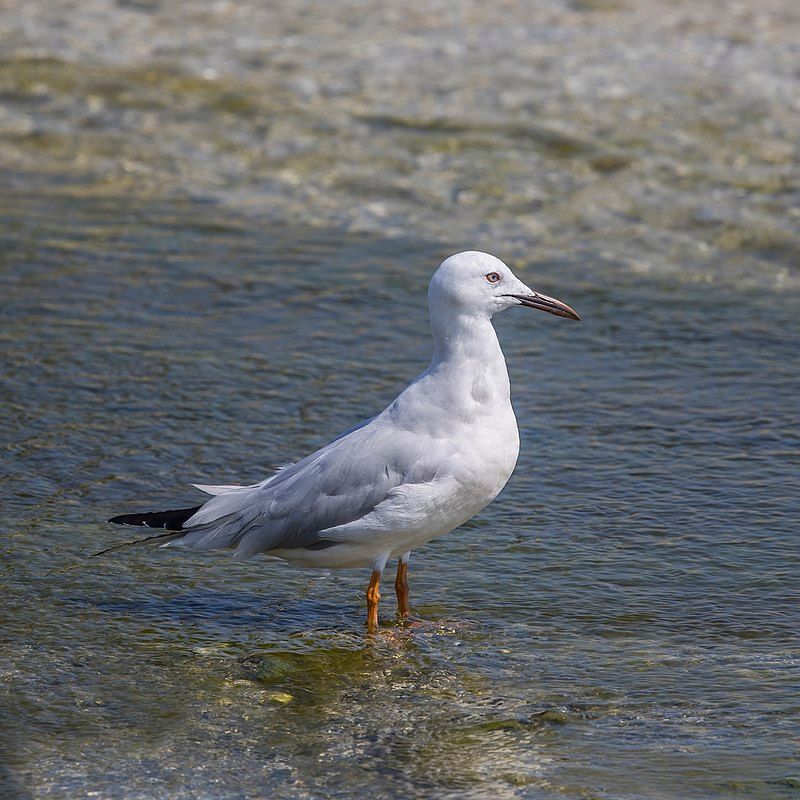
The slender-billed gull is a type of seagull found primarily in and around the Mediterranean Sea and the northern part of the western Indian Ocean. It is classified as a mid-sized gull, meaning it is smaller than some other species of seagulls.
This species of seagull breeds in very localized areas, generally on islands or in coastal lagoons. The majority of the population of this species is migratory, and they can be seen wintering in more southerly locations such as North Africa and India.
The slender-billed gull is a fascinating species of seagull that has adapted to its environment to survive.
| Kingdom | Animalia |
| Phylum | Chordata |
| Class | Aves |
| Order | Charadriiformes |
| Family | Laridae |
| Genus | Chroicocephalus |
| Species | C. genei |
21. Green Sandpiper
The green sandpiper is a type of small wading bird that is native to the Old World. It is in the genus Tringa, a relatively ancient lineage, and is closely related to the solitary sandpiper.
Both species have brown wings,, are speckled with small light dots,, and have a distinct pattern on the neck and chest. This pattern is delicate, but it stands out against the rest of the bird’s coloring.
Green sandpipers inhabit wetlands, such as marshes and shallow pools, and feed mainly on insects, worms, and other small aquatic creatures. They are migratory birds and can be seen in Europe, Asia, and North America during certain times of the year.
| Kingdom | Animalia |
| Phylum | Chordata |
| Class | Aves |
| Order | Charadriiformes |
| Family | Scolopacidae |
| Genus | Tringa |
| Species | T. ochropus |
22. Chukar
The chukar partridge, or simply chukar, is a species of upland gamebird belonging to the pheasant family Phasianidae. It is a Palearctic bird, which can be found in climates across the Northern Hemisphere.
Chukar is part of a superspecies complex along with three other partridge species: rock partridge, Philby’s partridge, and Przevalski’s partridge. In the past, these four species were treated as one species, likely because of their close similarities.
They have similar coloring and body shapes, as well as similar behavior and ecology. However, recent research has revealed that these birds are distinct species, though they remain closely related.
| Kingdom | Animalia |
| Phylum | Chordata |
| Class | Aves |
| Order | Galliformes |
| Family | Phasianidae |
| Genus | Alectoris |
| Species | A. chukar |
23. Spotted Redshank
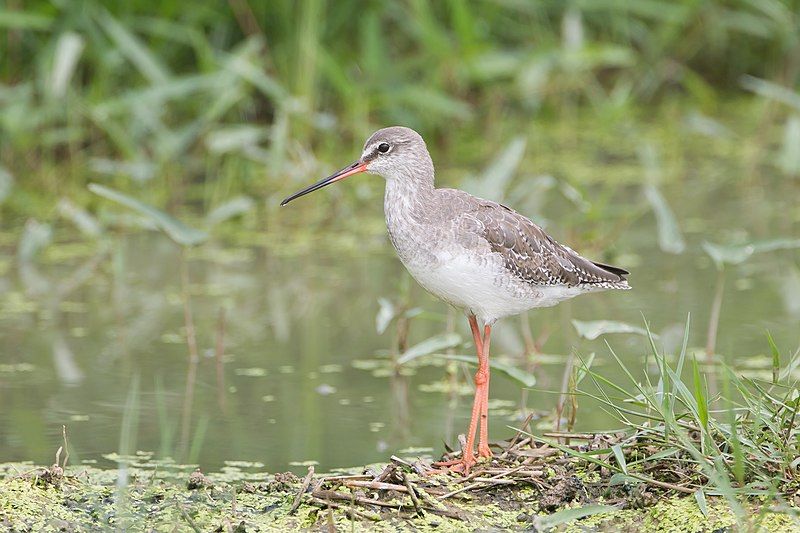
The spotted redshank is a species of wader part of the large bird family Scolopacidae. This family includes various shorebirds, including sandpipers, plovers, and phalaropes.
The spotted redshank is classified under the genus Tringa, derived from the Neo-Latin word given to the green sandpiper by Aldrovandus in 1599.
This name was based on the Ancient Greek word trungas, which was used to describe a thrush-sized bird with a white-rumped body and a habit of tail-bobbing while wading in water. Aristotle was the first to mention this bird in his writings.
The spotted redshank is a medium-sized wader found throughout much of Europe and Asia. The bird has a long, straight bill, reddish-brown plumage, and distinctive white spots on its wings and back.
It mainly feeds on insects, worms, and crustaceans and is usually seen foraging along the edges of wetlands and estuaries. During the breeding season, the spotted redshank migrates to the Arctic tundra, where it nests on the ground in wet meadows and tundra pools.
| Kingdom | Animalia |
| Phylum | Chordata |
| Class | Aves |
| Order | Charadriiformes |
| Family | Scolopacidae |
| Genus | Tringa |
| Species | T. erythropus |
24. Cattle Egret
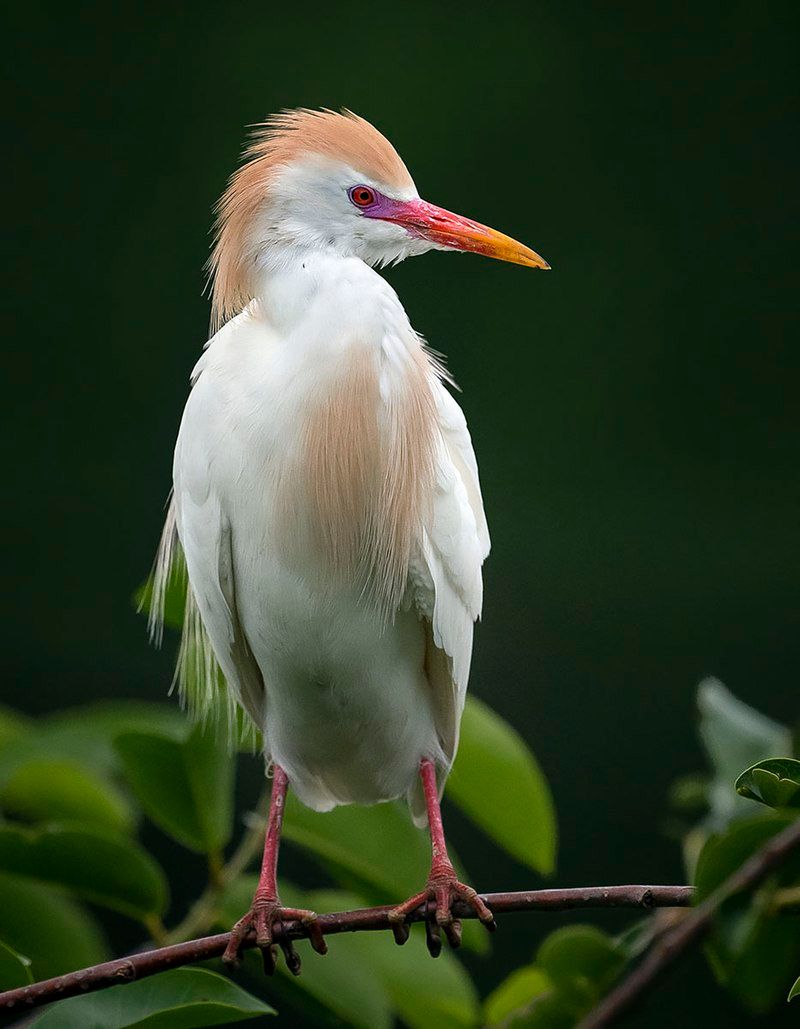
The cattle egret is a species of heron found throughout the world in many different climates, ranging from tropical to subtropical and warm-temperate.
It is the only member of its genus, Bubulcus, although some experts believe it has two distinct subspecies: the western and eastern cattle egret.
These two subspecies are considered to be distinct species in their own right and have been observed in different parts of the world, with the western species being more commonly found in North and South America, while the eastern species is found in Asia, Africa, and parts of Europe.
The cattle egret is a medium-sized wading bird and can reach up to 50 cm in length, with a wingspan of up to 1.2 meters.
It has a white body with a yellowish-orange crown and black legs. Its diet consists of small insects, frogs, and other small animals, which it catches by standing in shallow water and waiting for prey to come within reach.
It is also known to feed on the eggs and young of other water birds, such as ducks and geese. The cattle egret is a social bird and often forms large flocks, which can number in the thousands.
During the breeding season, the birds congregate in large colonies and pairs will nest close together in trees or shrubs. The female lays between two and five eggs, which both parents incubate.
The chicks are born blind and are cared for by both parents until they are ready to leave the nest.
| Kingdom | Animalia |
| Phylum | Chordata |
| Class | Aves |
| Order | Pelecaniformes |
| Family | Ardeidae |
| Genus | Bubulcus |
| Species | B. ibis |
Conclusion
Dakahlia is a great place for bird watching and birding. Its diverse habitats and abundant bird species provide an exciting chance to observe various birds.
The region is also home to some rare and endangered species, making it an ideal place for conservation efforts. Bird watching and birding in Dakahlia is an exciting and great way to appreciate and learn more about the avian world.